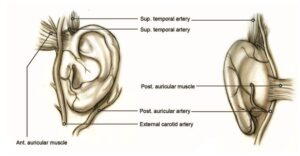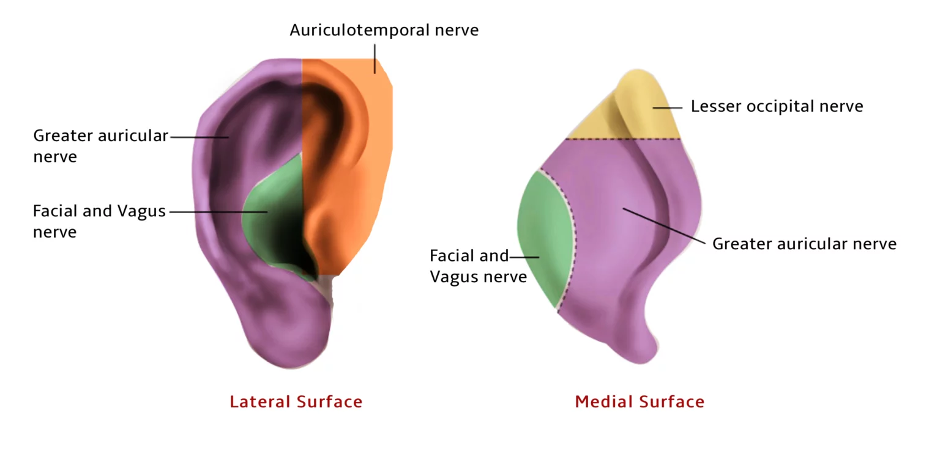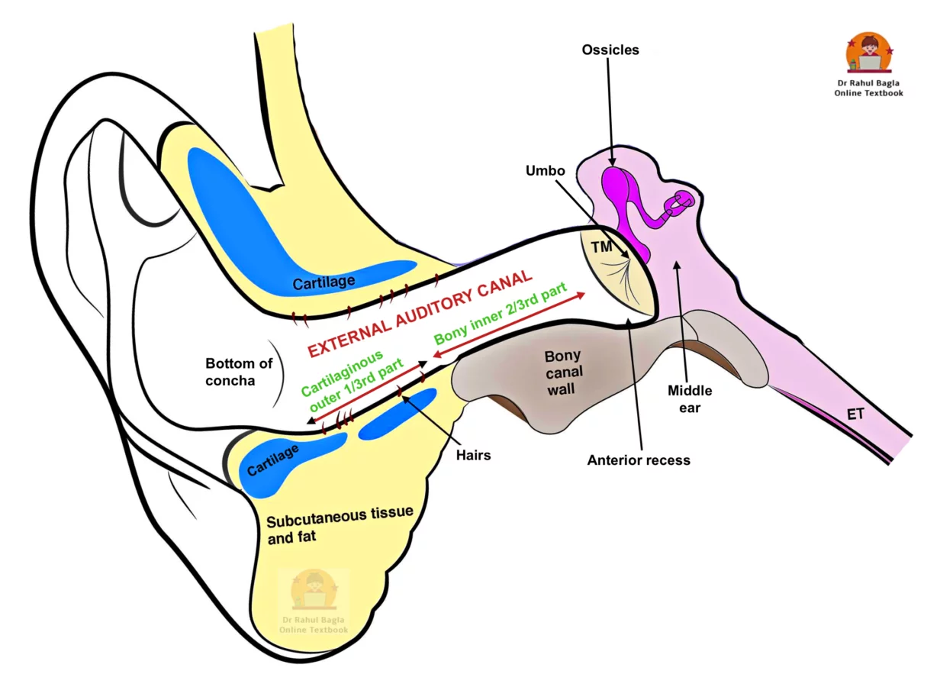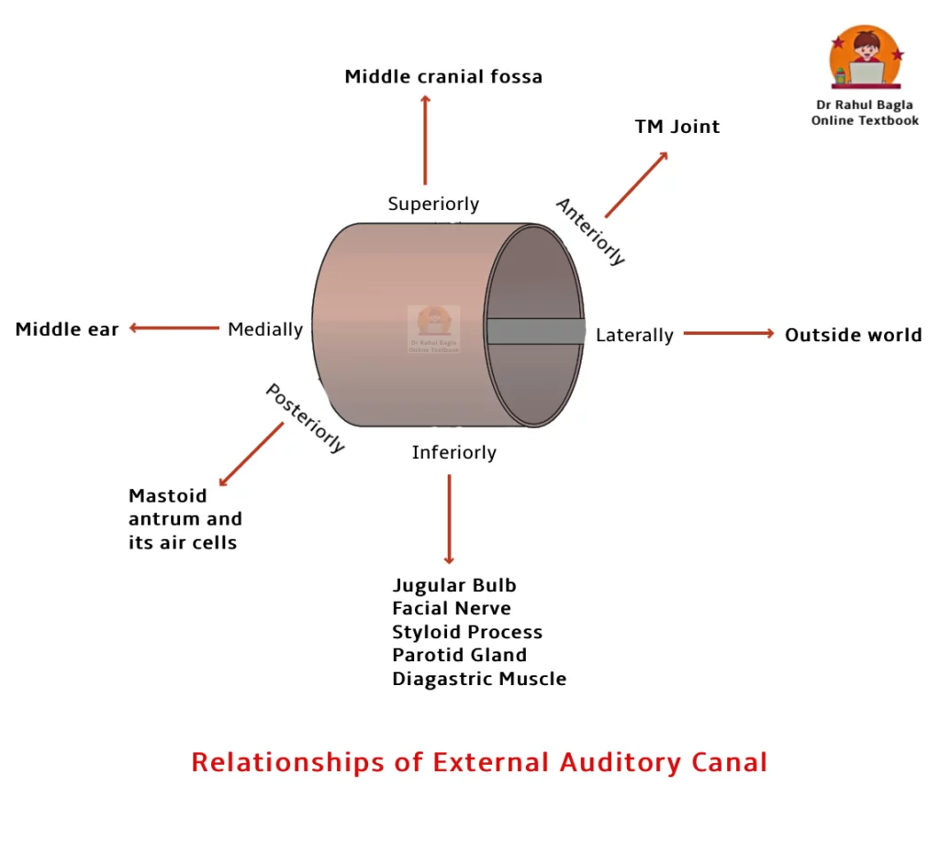The human ear is an important sense organ of our body. There are way more structures inside the ear than what we see. It consists of three parts —the outer external ear, the middle ear, and the inner ear. All three parts coordinate and collect sound from the surroundings and send it to the brain where speech and auditory centers translate the information. It serves two quite different functions: hearing and balance (equilibrium).
The ear also acts as a warning system from potentially threatening environmental sounds and forms a major part of a communication system. It also plays a major role in the balance system, coordinating head and eye movements during sudden changes in the environment, both external and self, to avoid falls and injury.

Anatomically, the ear is divided into three parts:
- External ear – It consists of a visible outer portion called the auricle or pinna, which is attached to the lateral aspect of the head and the external auditory canal which is closed by the tympanic membrane.
- Middle ear – It is an air-filled, mucous membrane-lined cavity in the petrous part of the temporal bone. It is present between the tympanic membrane laterally and the lateral wall of the internal ear medially. It contains a chain of three tiny bones (ossicles) – the malleus (hammer), incus (anvil), and stapes (stirrup). The middle ear is connected internally to the pharynx by a narrow eustachian tube.
- Internal ear or the labyrinth – The internal ear converts the mechanical signals received from the external and middle ear into electrical signals and transfer the information to the brain. It consists of a bony and a membranous labyrinth.
- Bony labyrinth is divided into two parts: (i) the vestibular apparatus, consisting of vestibule and semi-circular canals, which contains the sensory organs of postural equilibrium; and (ii) the snail-shell-like cochlea, which contains the sensory organ of hearing.
- Membranous labyrinth consists of utricle, saccule, semicircular ducts, cochlear duct. It contains clear fluid called endolymph. The space between membranous and bony labyrinths is filled with perilymph.
| Ear Functions | Hearing and maintaining balance of the body (equilibrium) |
| External ear | Parts: Auricle or pinna, External acoustic meatus, Tympanic membrane Function: Capture and conduction of sound |
| Middle ear | Parts: Tympanic cavity, Ear ossicles, Muscles of the ossicles Function: Transforming a high-amplitude low-force sound wave into a low-amplitude high-force vibration and transmitting it to the internal ear |
| Internal ear | Parts: Bony labyrinth (vestibular apparatus consisting of vestibule, semi-circular canals & cochlea) and Membranous labyrinth (utricle, saccule, semicircular ducts, cochlear duct) Function: – Utricle and saccule provide information about the position of the head – Semicircular ducts provide information about movements of the head – Cochlear duct provides hearing information |
THE EXTERNAL EAR
The external ear consists of the: (i) Auricle or pinna (ii) External acoustic canal (iii) Tympanic membrane.
(i) AURICLE OR PINNA
The auricle helps to focus and aid in the localization of sound waves in the environment. Except for its lobule, pinna consists of a single piece of yellow elastic cartilage, which is covered with skin. Adipose tissue is present only in the lobule. The contour of the pinna is determined by the configuration of its elastic cartilage frame. This single cartilage also forms outer 1/3rd part of external acoustic canal.
Cartilage from the tragus, perichondrium from the tragus or concha and fat from the lobule are frequently used grafts for reconstructive surgery of the middle ear. The conchal cartilage is used to correct the depressed nasal bridge. Composite grafts of the skin and cartilage are used for repair of defects of nasal ala.
There are two surfaces of the auricle: and medial (inner) and lateral (outer). The skin over the pinna is tightly bound to its perichondrium on the lateral surface while it is loosely attached on medial surface. The medial surface is attached to the skull and has no major importance. The lateral aspect is concave and arranged in a pattern of various prominences and depressions.
Prominences and depressions of pinna:
- The outside rim is called helix and it ends inferiorly at the lobule.
- A smaller curved rim, parallel and anterior to the helix, is the antihelix.
- The large hollow centre area is called concha.
- The external acoustic meatus starts from bottom of the concha.
- Just anterior to the opening of the external acoustic meatus and in front of the concha, is an elevation (the tragus).
- Opposite the tragus, is another elevation called antitragus.

Muscles of pinna:
- The extrinsic muscles (three in number), the anterior, superior, and posterior auricular muscles, which pass from the scalp or skull to the auricle and may also play a role in positioning of the auricle.
- The intrinsic muscles (six in number) pass between the cartilaginous parts of the auricle and may change the shape of the auricle. They are small, inconsistent and without useful function. Both groups of muscles are innervated by the facial nerve.
Blood Supply of pinna:
- Posterior auricular artery – Branch of external carotid artery. It is the main artery of pinna, which supplies the medial surface (except the lobule), the concha, the middle and lower portions of the helix and the lower part of the antihelix.
- Anterior auricular artery – Branch of superficial temporal artery. It supplies the upper portions of the helix, antihelix, triangular fossa, tragus and lobule.
- Small auricular branch from the occipital artery may aid the posterior auricular artery.

Blood Supply of Pinna
Venous drainage of pinna is through vessels following the arteries.
Lymphatic drainage of pinna:
- From medial surface to the lymph nodes at the mastoid tip
- From tragus and upper part of the lateral surface to the preauricular nodes
- From remaining auricle to the upper deep cervical nodes.
Nerve supply of pinna:
- Auriculotemporal nerve (branch of mandibular division of trigeminal nerve, V3): It supplies anterosuperior part of lateral surface of pinna including tragus and crus of helix.
- Greater auricular nerve (C2,3): This nerve of cervical plexus supplies most of the outer medial surface of auricle and posterior part of lateral surface and the postauricular region.
- CN VII (facial nerve): It innervates the skin of lateral concha and antihelix, lobule and mastoid.
- CN X (vagus nerve): Its auricular branch (Arnold’s nerve) supplies to concha and postauricular skin.
- Lesser occipital nerve (C2): This nerve of cervical plexus supplies upper part of medial surface of auricle and postauricular region.

(ii). EXTERNAL AUDITORY (ACOUSTIC) CANAL
External auditory canal (EAC) extends from the bottom of the concha to the tympanic membrane. It measures about approximately 24 mm (1 inch) along its posterior wall and anterior wall is 6 mm longer than the posterior wall. The diameter of the canal is wider laterally and narrow medially.
Its walls is formed by cartilage and bone and therefore divided into
(a) cartilaginous outer (lateral) one-third part (8 mm)
(b) bony inner (medial) two-third part (16 mm).
Its direction is not straight. It is S-shaped; its cartilaginous part is directed upwards, backwards and medially while its bony part is directed downwards, forwards and medially. Therefore to examine the canal and tympanic membrane, the pinna is gently pulled upwards, backwards and laterally to bring both the cartilaginous outer one-third part and the bony inner two-thirds part in alignment.
But, to examine the canal and tympanic membrane in neonates, the pinna is gently pulled downwards, backwards and laterally, as the bony inner two-third part is not developed in neonates.

A. Cartilaginous Part
The cartilaginous outer (lateral) one-third part is formed by the same single piece of yellow elastic cartilage, which formed the framework of pinna. It is attached to the bony inner part by fibrous bands. The skin over the cartilaginous canal is thick and contains hairs and modified apocrine sweat glands (ceruminous and pilosebaceous glands) which produce wax (mixture of desquamated cells, cerumen and sebum). Hairs are only present in the cartilaginous part and helps to prevent the entrance of foreign bodies. Therefore furuncles (staphylococcal infection of hair follicles) are seen only in this part.
There are two horizontal deficiencies-the “fissures of Santorini” present in the floor of cartilaginous part. These fissures increases the flexibility of the canal but allows invasion of infections (e.g. malignant otitis externa) and neoplasms to and from parotid and temporo-mandibular regions.
B. Bony Part
The bony inner (medial) two-third part is narrow and its medial end is marked by a groove, called tympanic sulcus, which is absent superiorly. This part is mainly formed by the tympanic part of temporal bone but roof is formed by the squamous part of the temporal bone. There are no hairs and ceruminous glands in this part.
The skin over the bony canal is thin and it is continuous over the tympanic membrane. About 5-6 mm lateral to tympanic membrane, there is prominence called “isthmus“, which narrows the diameter of bony canal. Foreign bodies, lodged medial to the isthmus, get impacted, and are hard to remove. Beyond the isthmus, the anteroinferior part of the deep meatus dips forwards forming a wedge-shaped “anterior recess“. This recess acts as a gutter for ear discharge and debris and becomes a tough spot to access either in the clinic or at surgery. Wax is usually not seen in this part and if present over pars flaccida or attic region is rarely true wax. It is almost always associated with an underlying cholesteatoma. Sagging of posterosuperior part of deep bony part is seen in acute mastoiditis because it is related with the mastoid antrum.
Foramen of Huschke is present in the anteroinferior part of bony canal. It is seen up to the age of four or sometimes even in adults, but usually gets closed by adolescence. Like fissures of Santorini, it also allows invasion of infections (e.g. malignant otitis externa) and neoplasms to and from parotid and temporo-mandibular regions.
Anatomy of Ear Anatomy of Ear
Relationships of EAC:-
- Superior: Middle cranial fossa
- Inferior: Parotid gland
- Posterior: Mastoid antrum and air cells and the facial nerve
- Anterior: Temporomandibular joint (TMJ)
- Medial: Tympanic membrane and middle ear
- Lateral: Outside world

Nerve Supply:
- Auriculotemporal nerve (CN V3): It is a branch of mandibular division of trigeminal nerve and supplies anterior and superior walls of external auditory canal.
- CN X (vagus nerve): Its auricular branch (Arnold’s nerve) supplies to posterior and inferior walls of external auditory canal.
- CN VII (facial nerve): It innervates the skin of the mastoid and posterior external auditory canal.
Important clinical points:
- Hitzelberger’s sign: The hypoesthesia of posterior meatal wall occurs due to the pressure on facial nerve (sensory fibers are affected early) in patients with acoustic neuroma.
- Vasovagal reflex: While cleaning the EAC, patient may develop coughing, bradycardia, syncope and even cardiac arrest. They can occur because of Arnold’s branch of vagus nerve.
- Ramsay Hunt syndrome: Vesicles of herpes zoster oticus occur on mastoid and posterior meatal wall which indicate that this part of external ear has facial nerve innervation.
—— End of the chapter ——
Anatomy of Temporal Bone Anatomy of Temporal Bone Anatomy of Temporal Bone Anatomy of Temporal Bone Anatomy of Temporal Bone, Anatomy of Temporal Bone, Anatomy of Temporal Bone, Anatomy of Temporal Bone, Anatomy of Temporal Bone, Anatomy of Temporal Bone, Anatomy of Temporal Bone, Anatomy of Temporal Bone, Anatomy of Temporal Bone, Anatomy of Temporal Bone
-
Follow our Facebook page: https://www.facebook.com/Dr.Rahul.Bagla.UCMS
-
Join our Facebook group: https://www.facebook.com/groups/628414274439500
-
Read chapter Glomus Tumour. https://www.entlecture.com/glomus-tumour/
Learning resources.
- Scott-Brown, Textbook of Otorhinolaryngology Head and Neck Surgery.
- Glasscock-Shambaugh, Textbook of Surgery of the Ear.
- Susan Standring, Gray’s Anatomy.
- Frank H. Netter, Atlas of Human Anatomy.
- B.D. Chaurasiya, Human Anatomy.
- P L Dhingra, Textbook of Diseases of Ear, Nose and Throat.
- Hazarika P, Textbook of Ear Nose Throat And Head Neck Surgery Clinical Practical.
- Mohan Bansal, Textbook of Diseases of Ear, Nose and Throat Head and Neck surgery.
Author:

Dr. Rahul Kumar Bagla
MS & Fellow Rhinoplasty & Facial Plastic Surgery.
Associate Professor
GIMS, Greater Noida, India
msrahulbagla@gmail.com
Please read. Glomus Tumour. https://www.entlecture.com/glomus-tumour/
Follow our Facebook page: https://www.facebook.com/Dr.Rahul.Bagla.UCMS
Join our Facebook group: https://www.facebook.com/groups/628414274439500
